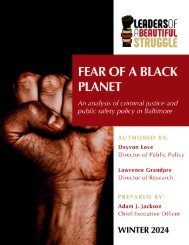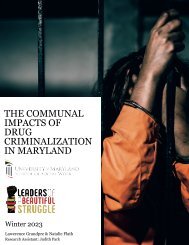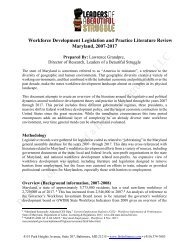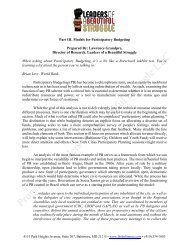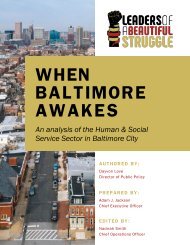Drug Decriminalization in Maryland Through an African Centered Research Paradigm- Analysis and Recommendations
This document offers guidance for theorizing questions related to a proposed research project purposed to advance drug decriminalization in Maryland.
This document offers guidance for theorizing questions related to a proposed research project purposed to advance drug decriminalization in Maryland.
- No tags were found...
You also want an ePaper? Increase the reach of your titles
YUMPU automatically turns print PDFs into web optimized ePapers that Google loves.
commissions have the authority to b<strong>an</strong> <strong>in</strong>dividuals from visit<strong>in</strong>g certa<strong>in</strong> areas <strong>an</strong>d hav<strong>in</strong>g<br />
relationships with <strong>in</strong>dividuals the court deems <strong>in</strong>appropriate, writ<strong>in</strong>g:<br />
For offenders who do not fall <strong>in</strong>to the dismissal category, the p<strong>an</strong>els c<strong>an</strong> take a r<strong>an</strong>ge of<br />
action, <strong>in</strong>clud<strong>in</strong>g issu<strong>in</strong>g a warn<strong>in</strong>g to the offender, requir<strong>in</strong>g the offender to check <strong>in</strong> with<br />
the p<strong>an</strong>el at specified times, order<strong>in</strong>g the offender to enter <strong>in</strong>to a treatment program, <strong>an</strong>d<br />
even b<strong>an</strong>n<strong>in</strong>g the offender from visit<strong>in</strong>g certa<strong>in</strong> places or associat<strong>in</strong>g with certa<strong>in</strong> people…<br />
(Kreitt, 2010).<br />
When operat<strong>in</strong>g from <strong>an</strong> underst<strong>an</strong>d<strong>in</strong>g of the function<strong>in</strong>g of Anti-blackness, few th<strong>in</strong>gs could be<br />
more concern<strong>in</strong>g th<strong>an</strong> a public policy which creates legal authority for view<strong>in</strong>g entire communities<br />
as devi<strong>an</strong>t <strong>an</strong>d/or d<strong>an</strong>gerous. While this concept is prom<strong>in</strong>ent <strong>in</strong> contemporary americ<strong>an</strong> law<br />
enforcement, with parole violations automatically apply<strong>in</strong>g to certa<strong>in</strong> <strong>in</strong>dividuals found <strong>in</strong> “known<br />
drug traffick<strong>in</strong>g areas”, these notions have been critical tools <strong>in</strong> justify<strong>in</strong>g systemic over polic<strong>in</strong>g<br />
of Black neighborhoods, deemed as <strong>in</strong>herently crim<strong>in</strong>al <strong>an</strong>d devi<strong>an</strong>t. It seems unlikely that large,<br />
predom<strong>in</strong><strong>an</strong>tly white suburb<strong>an</strong> communities, despite hav<strong>in</strong>g equal rates of drug use as poor <strong>an</strong>d<br />
work<strong>in</strong>g class urb<strong>an</strong> areas, would receive these sort of “no go zone” designation, creat<strong>in</strong>g a<br />
powerful tool for replicat<strong>in</strong>g racial bias. However, one need only have a basic underst<strong>an</strong>d<strong>in</strong>g of<br />
hum<strong>an</strong> nature <strong>an</strong>d the culture of people of Afric<strong>an</strong> descent to underst<strong>an</strong>d how problematic this<br />
authority c<strong>an</strong> be. If there is <strong>an</strong>y proof to Alex<strong>an</strong>der’s theory of “psycho-social <strong>in</strong>tegration”, or the<br />
connection between <strong>in</strong>dividuals <strong>an</strong>d feel<strong>in</strong>g of hav<strong>in</strong>g a social support system <strong>an</strong>d community,<br />
be<strong>in</strong>g a critical part of the addiction epidemic, there are few easier way to create a crisis of psychosocial<br />
<strong>in</strong>tegration th<strong>an</strong> to legally b<strong>an</strong> <strong>in</strong>dividuals from engag<strong>in</strong>g with people <strong>in</strong> their community.<br />
While some <strong>in</strong> this community might create factors which drive people toward addiction, others<br />
<strong>in</strong> the same community are likely key to creat<strong>in</strong>g alternative forms of psycho-social <strong>in</strong>tegration<br />
that c<strong>an</strong> create the social networks needed to prevent drug use from slid<strong>in</strong>g <strong>in</strong>to full blown<br />
addiction. Beyond the meta level <strong>an</strong>alysis, social connections <strong>in</strong> community are essential for<br />
<strong>in</strong>dividuals to f<strong>in</strong>d jobs <strong>an</strong>d hous<strong>in</strong>g, necessarily stabiliz<strong>in</strong>g factors to create social stability. All<br />
of these factors are magnified when seen through the lens of people of Afric<strong>an</strong> descent. The notion<br />
of ubuntu is also known as “collective subjectivity”, with the <strong>in</strong>dividual see<strong>in</strong>g the basic unit of<br />
social <strong>an</strong>d political life as the community, not the wetern, autonomous, “rational” <strong>in</strong>dividual (Ani,<br />
1994). From the perspective of a culture which operates through collective subjectivity, cutt<strong>in</strong>g<br />
<strong>in</strong>dividuals off from the community is not only a punishment for the <strong>in</strong>dividual, it is a punishment<br />
for the entire community, who see their relationship with the excluded <strong>in</strong>dividual as a necessary<br />
part of their own subjective flourish<strong>in</strong>g. All this needs to be seen with<strong>in</strong> the context of <strong>an</strong>ti-black<br />
notion of the need to “rescue” Black people from their pathological <strong>an</strong>d dev<strong>in</strong>ate Black<br />
communities. What Ibrahim X Kendi call <strong>an</strong> “assimilationist” impulse, i.e. the notion that Black<br />
people need socialization <strong>an</strong>d civilization <strong>in</strong>fluence by engag<strong>in</strong>g with whtie people, white<br />
communities, <strong>an</strong>d whtie <strong>in</strong>stitutions, has been <strong>an</strong> essential fulcrum of Anti-Black policy <strong>an</strong>d<br />
practice <strong>in</strong> America s<strong>in</strong>ce the 1600s (Kendi, 2017). Few policies more neatly fit with<strong>in</strong> Anti-Black<br />
assimilationist assumptions th<strong>an</strong> b<strong>an</strong>n<strong>in</strong>g <strong>in</strong>dividuals from be<strong>in</strong>g around their community <strong>an</strong>d<br />
potentially forc<strong>in</strong>g them <strong>in</strong>to forms of drug treatment which, as 12 Step derived drug treatment<br />
often does, argues for “cutt<strong>in</strong>g off” <strong>in</strong>dividual <strong>in</strong> your past life of us<strong>in</strong>g drugs or <strong>an</strong>y “negative<br />
4151 Park Heights Avenue, Suite 207, Baltimore, MD 21215 • www.lbsbaltimore.com • (410) 374-7683




